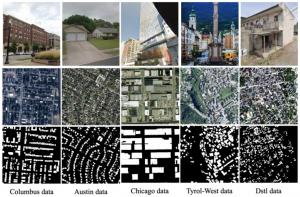Synthetic Data Matters: A New Era of Geo-Intelligent Earth Observation
The Problem: A Planet Too Large for Human Labeling
Earth sciences and their allied domains—remote sensing, urban mapping, agriculture, resource monitoring, defense, disaster response, infrastructure, weather, and water systems—make up a major part of global STEM. Yet all these fields depend on annotated geospatial data, which remains painfully expensive.
In remote sensing, traditional labeling has become a bottleneck.
The GBSS dataset, for instance, covers 1,310 km² of nearly ALL open-source building segmentation labels—barely 0.18% of the world’s 2010 urban built-up area (≈ 747,050 km²). Scaling this globally is nearly impossible.
The USGS Chesapeake LULC project cost $1.3 million for just 160,000 km², taking 10 months to complete. That’s $8.1 per km². At this rate, mapping the entire U.S. (≈ 9.15 million km²) would require $74 million and nearly 48 years to finish one full update cycle.
Even worse, if the nation demanded annual updates, the 10-year cost would exceed $743 million.
Under high-fidelity LiDAR mapping (costing $4,000–$12,000 per km²), one nationwide update would reach $36–$110 billion, or $365 billion–$1.1 trillion over a decade.
The cost of keeping America’s land-use maps current is staggering—financially, temporally, and operationally.
The Breakthrough: Geo-Typical Synthetic Data
Instead of chasing bigger synthetic datasets, OSU’s CEGE scientists took a different path.
Their approach generates geo-typical synthetic data—artificial imagery that mirrors the target region’s special city layout, building types, and environmental conditions.
Using OpenStreetMap street networks, procedural city modeling, and physics-based rendering, they produce very-high-resolution synthetic images that replicate the true “texture” of each city.
They then integrate this into an adversarial domain-adaptation framework, enabling deep-learning models to “retrain themselves” at test time, adapting to new cities automatically.
The result: models that generalize across regions, with median performance gains up to 12%, and a cost reduction of 50–90% in labeling and data acquisition.
Impact: From Decades to Days
This invention turns what used to take decades into something that can happen on demand, city by city, in days.
A process that once required 47 years for nationwide coverage can now be executed incrementally, whenever and wherever needed—after earthquakes, hurricanes, or urban changes.
At a national scale, this approach could save $372–669 million over the next decade, while drastically accelerating the refresh cycle of U.S. geospatial infrastructure.
It transforms “massive one-off national projects” into agile, continuously updated systems.
A Structural Transformation for the U.S. Economy and Talent Pipeline
The remote sensing and synthetic data market—valued at $17.53 billion in 2022—is projected to reach $42.64 billion by 2030.
With synthetic and domain-adaptive AI expected to represent 15–25% of this market, the emerging sector could generate $6.4–10.7 billion annually, translating to 30,000–50,000 new high-skill jobs across software engineering, procedural modeling, and Earth AI.
The shift is profound: from a data-collection-heavy economy to a knowledge-driven, algorithmic economy—one that secures America’s leadership in geospatial intelligence and scientific innovation.
Scientific and Institutional Significance
This research marks a paradigm shift in how synthetic data is viewed in Earth observation—from “unreliable” to indispensable.
It enables precise building detection even in regions with minimal labeled data, supporting faster recovery in disasters, smarter urban planning, and stronger national resilience.
Funding from the Office of Naval Research and the Intelligence Advanced Research Projects Activity (IARPA) underscores federal interest. The USGS has also begun exploring follow-up applications.
A New Era in Seeing the Earth
The vision is simple yet monumental:
to teach machines to see the world as it truly is, not by collecting endless data, but by re-creating the world in silico—faithful to its geography, its light, its structure.
From “decades-long national updates” to “real-time adaptive intelligence,”
from “data scarcity” to “synthetic abundance,”
this work from Ohio State’s Laboratory is not merely an academic milestone—it is the dawn of a new era in how humanity maps, understands, and safeguards its world.
Article Title: Synthetic Data Matters: Retraining With Geo-Typical Synthetic Labels for Building Detection
Authors: Shuang Song; Yang Tang; Rongjun Qin
Article References:
S. Song, Y. Tang and R. Qin, "Synthetic Data Matters: Retraining With Geo-Typical Synthetic Labels for Building Detection," in IEEE Transactions on Geoscience and Remote Sensing, vol. 63, pp. 1-13, 2025, Art no. 5635613, doi: 10.1109/TGRS.2025.3593864.
Link: https://doi.org/10.1109/TGRS.2025.3593864
DOI: 10.1109/TGRS.2025.3593864
Keywords: Buildings, Synthetic data, Urban areas, Data models, Image segmentation, Adaptation models, Layout, Remote sensing, Satellite images, Roads
Yangxue
The Ohio State University
email us here
Legal Disclaimer:
EIN Presswire provides this news content "as is" without warranty of any kind. We do not accept any responsibility or liability for the accuracy, content, images, videos, licenses, completeness, legality, or reliability of the information contained in this article. If you have any complaints or copyright issues related to this article, kindly contact the author above.



